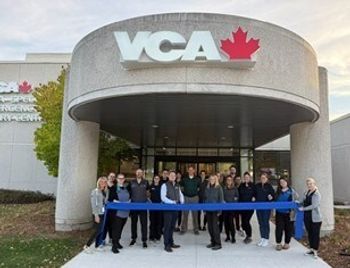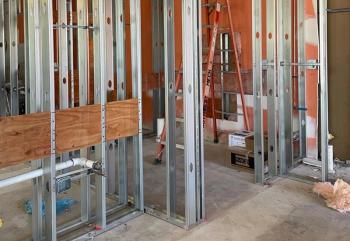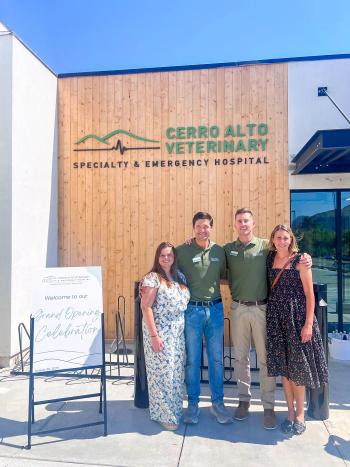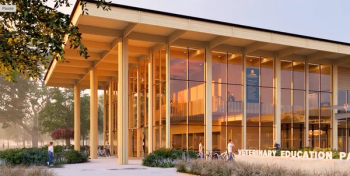
California hospital wins top design honors
Drs. Tia Greenberg and Heidi Tschauner admit that patience is not one of their virtues. With a bit less than 10 years of practice experience, the doctors joined forces to start their own veterinary hospital in a brand-new, 8,815-square-foot facility. "Our experiences working in other practices taught us how important it was that our floor plan to promote an efficient flow of traffic and that we wanted a facility that felt warm and welcoming," Dr. Tschauner says. The product of this vision, Westminster Veterinary Group in Westminster, Calif., earned the 2002 Hospital of the Year award in the 37th annual Veterinary Economics Hospital Design Competition.
By Carolyn Chapman
Special Assignments Editor
Drs. Tia Greenberg and Heidi Tschauner admit that patience is not one of their virtues. With a bit less than 10 years of practice experience, the doctors joined forces to start their own veterinary hospital in a brand-new, 8,815-square-foot facility. "Our experiences working in other practices taught us how important it was that our floor plan to promote an efficient flow of traffic and that we wanted a facility that felt warm and welcoming," Dr. Tschauner says. The product of this vision, Westminster Veterinary Group in Westminster, Calif., earned the 2002 Hospital of the Year award in the 37th annual Veterinary Economics Hospital Design Competition.
Hospital design judges applauded the floor plan's smooth traffic flow and ample windows. "It's absolutely beautiful throughout," said one competition judge. "I couldn't find a negative aspect of this hospital," remarked another.
An early vision
Drs. Greenberg and Tschauner met in the early 1990s while attending veterinary school at Ross University in St. Kitts, West Indies. Dr. Greenberg completed an externship at the Animal Medical Center of New York, and Dr. Tschauner joined the same hospital as an intern. The two shared the same vision for running a veterinary practice. So they headed for Dr. Tschauner's home state of California and worked as associates in Orange County at separate veterinary practices while they looked for an opportunity to strike out on their own.
The pair originally planned to buy an existing practice but decided it would be easier to start from scratch. "I knew we wouldn't be happy unless we built our own hospital," Dr. Greenberg says. And they decided they wanted to dream big. "It was a common theme in the hospital design articles we read in Veterinary Economics that practitioners started too small and needed more space," says Dr. Tschauner. "We chose to build a large hospital to grow into." The doctors obtained financing from private investors on the East coast and began looking for space to build.
Prohibitive land costs in Southern California pushed the doctors to look for a large leasehold space that would accommodate a freestanding building. They found the right location in a shopping center complex in Westminster, Calif., a diverse working-class and professional community, and signed a 30-year lease.
The building owner wanted to stipulate a build-to-suit arrangement, but the doctors convinced the owner to give them $650,000 to build the shell and install mechanical systems. Anything more than $650,000, the practitioners paid themselves. "This arrangement gave us more freedom to build the facility we wanted," Dr. Tschauner says.
Word-of-mouth referrals and hospital design articles led the veterinarians to award-winning veterinary architect Richard Rauh, of Rauhaus Architects in Lake Forest, Calif. They relayed their vision, which he translated to paper. They spent nearly six months finalizing the design.
"It was important to us to separate ancillary services from medical services," Dr. Greenberg says. The doctors also wanted to include lots of interior windows for monitoring and skylights to give the hospital an open feel. And they wanted client traffic to move smoothly through the practice. "I imagined myself walking through a typical client visit and routed the flow accordingly," Dr. Tschauner says.
Rauh says teamwork made the project successful. "Every detail came together, because we all focused on breaking away from traditional thinking to make a cutting-edge statement," Rauh says.
Research reaps rewards
At the project's onset, both doctors worked full time, but when construction began, Dr. Tschauner cut back to visit the construction site more often. She praises their contractor, Fred Babuscio, who was on call whenever the doctors needed him. "He and Rich had worked together on several projects, so we were able to eliminate many communication problems from the beginning," Dr. Greenberg says.
Dealing with the city and the developer proved to be the doctors' biggest challenge. For example, city planners insisted on locating an old English phone booth outside their doors. The veterinarians and Rauh fought to remove that stipulation-and won. The design team also faced restrictions on signage, plants, and wall height. And the city demanded the doctors fund a $30,000 traffic study required of new 100-client-a-day human hospitals. After six months of homework, the doctors found that a $6,000 study better reflected their business-and the city agreed.
They also overcame differences of opinion with the developer, Rauh says. For example, the developer wanted the hospital to connect physically with the shopping center. But Rauh says computer modeling helped convince the city and the developer that a stand-alone facility was better.
Mediterranean flair
The shopping center's design set the tone for the hospital's Italian-inspired exterior. Even the flowers and the swaying palm fronds match the orange and green building accents. Unlike the rest of the shopping center, Westminster Veterinary Group features sweeping, curved exterior walls to give the exterior depth and to lead the eye to the main entry-which features an elevated orange roof and bold arches. The walls also complement the main interior design elements, which combine flowing lines and bold geometric shapes.
Inside, a round reception desk and planters continue the themes set with the exterior, and the miniature palm trees add interest to the spacious room. A large skylight floods the reception area with natural light and gives it an open feel. The only feature the doctors would like to change is the flooring. "The Marnoleum vinyl flooring looks nice, but it shows dog scratches," says Dr. Greenberg. "We'd like to install tile or an epoxy floor in the future."
The practice owners credit interior designer Alice Fong, of Fresh Design in Los Angeles, with giving their hospital a unified look. When the duo met with Fong to discuss colors, Fong had prepared a color palette the veterinarians adored. "It was like she read our minds," Dr. Tschauner says. "She really made it fun," Dr. Greenberg adds.
Five exam rooms sit along the south side of the reception area, with a storage area, a janitor's closet, the business office, and an associate doctors' office at the west end. Team members access the pharmacy and a write-up station either through the exam rooms or by using the hall at either end of the exam rooms. The pharmacy features a pass-through to the centrally located lab and nurses' station. "Our veterinary nurses are able to enter client charges right there instead of leaving the treatment area to find an office," Dr. Greenberg says.
The treatment area serves as a hub for two ICU rooms, a special-procedures room, the surgery suite, and the doctors' office. Floor-to-ceiling glass keeps all areas visible. "The windows reduce steps and improve efficiency," Dr. Greenberg says. Across the hall from the treatment area, the staff lounge offers employees access to an outdoor patio.
Two exotics wards, located directly south of the staff lounge, house pocket pets and birds. Often, the veterinarians use one ward to treat injured wildlife. "We developed the nonprofit Orange County Wildlife Foundation as a way to rehabilitate and release injured wildlife," says Dr. Tschauner. "It's also a way to give something back to the community."
The boarding area, located at the back of the practice to minimize noise in the rest of the hospital, includes two cage wards and one run ward and features skylights to bring in natural light. The row of luxury dog suites includes VCRs with TV monitors and glass doors. The isolation unit, near boarding, features 100 percent exhaust to prevent contamination. Five different environmental zones help keep the hospital quiet and odor-free.
Preparing for success
Before building a new veterinary hospital, Drs. Greenberg and Tschauner recommend that you take the time to define and refine your practice goals. "I was approaching my 10-year veterinary school graduation mark, and I really thought about where I wanted my career to go," says Dr. Tschauner. "Building a new practice seemed like the next logical step."
The doctors also looked for creative ways to maximize the success of their start-up practice. For example, Drs. Greenberg and Tschauner invited Dr. Thomas Schwartz, a long-established local veterinarian, to join them. "Dr. Schwartz's decision to close his practice doors and move his clients to the new facility gave us a better base to build from," Dr. Greenberg says.
Looking at their finished hospital design project, Dr. Tschauner focuses in on the words carved on the four pillars in the reception area: quality, compassion, integrity, and service. "We built a veterinary hospital that helps us fulfill these critical commitments to our clients and patients," she says. "I have everything I've ever wanted," Dr. Greenberg echoes.
Carolyn Chapman, a former Veterinary Economics associate editor, is a freelance writer in Liberty, Mo. Chapman has written for Veterinary Economics since 1994.
Newsletter
From exam room tips to practice management insights, get trusted veterinary news delivered straight to your inbox—subscribe to dvm360.






